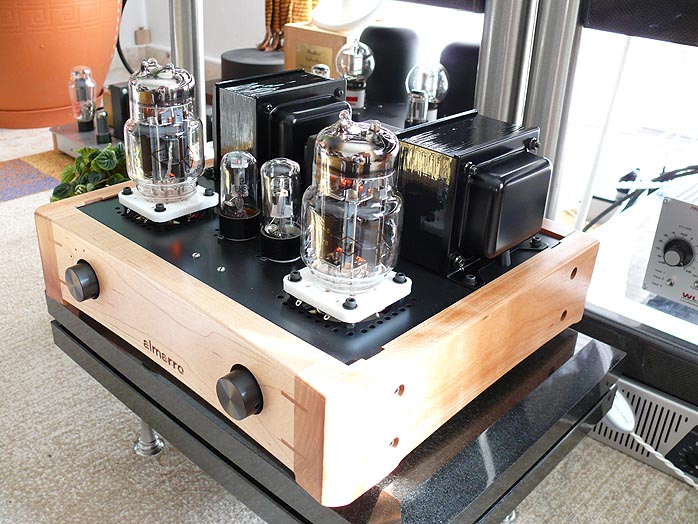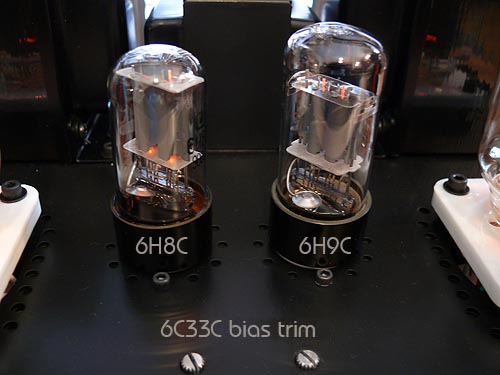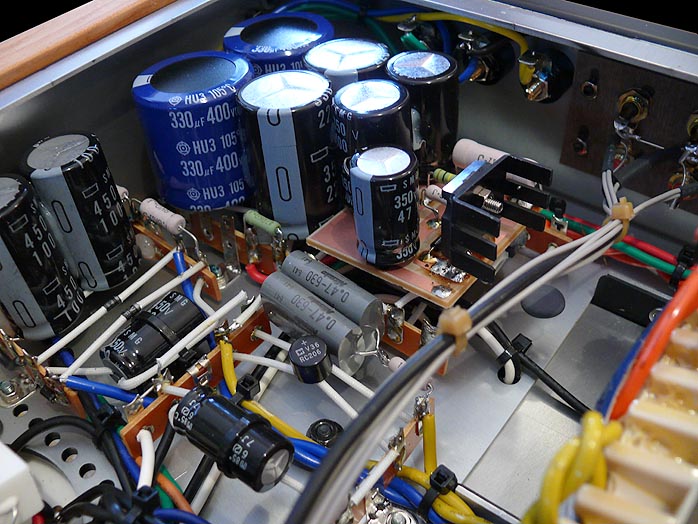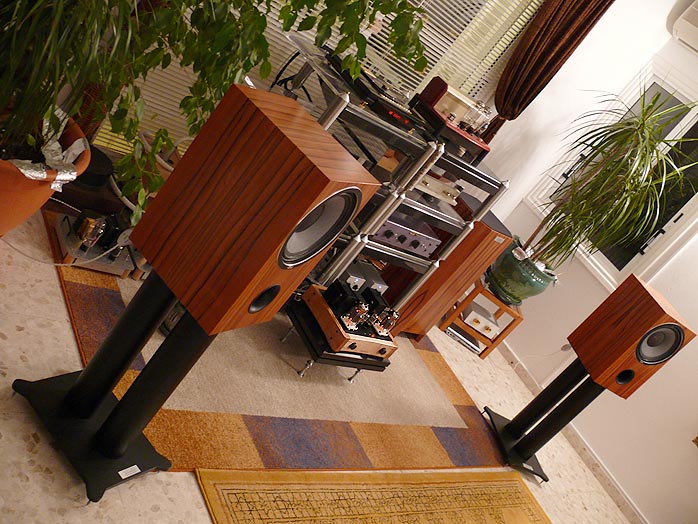|
|
|
|
|
This review page is supported in part by the sponsor whose ad is displayed above
|
|
 |
|
 |
|
|
|
|
 |
|
 |
|
Reviewer: Srajan Ebaen
Source: Zanden Audio Model 2000P/5000S; Ancient Audio Lektor Prime; Raysonic CD-128; AMR CD-77 [on review]
Preamp/Integrated: Supratek Cabernet Dual; Wyetech Labs Jade; ModWright SWL 9.0SE; Bel Canto PRe3
Amp: 2 x Audiosector Patek SE; First Watt F3; Yamamoto A-08s
Speakers: Zu Audio Definition Pro with Gallo Ref 3 SA bass amp/crossover/EQ; Mark & Daniel Ruby with OmniHarmonizer; WLM Diva Monitor with Duo 12 passive subwoofer, Alto bass amp, Pre/Passive and Bass Controls; Gallo Acoustics Ref 3.1; DeVore Fidelity Nines [on review]; Mark & Daniel Maximus Monitor [on review]
Cables: Crystal Cable Ultra loom; Zanden Audio proprietary I²S cable; Crystal Cable Reference power cords; double cryo'd Acrolink with Furutech UK plug between wall and transformer
Stands: 2 x Grand Prix Audio Monaco Modular 4-tier
Powerline conditioning: 2 x Walker Audio Velocitor S fed from custom 117V AudioSector 1.5KV Plitron step-down transformer with balanced power output option; Furutech RTP-6 on 230V line
Sundry accessories: GPA Formula Carbon/Kevlar shelf for transport; GPA Apex footers underneath stand, DAC and amp; Walker Audio Extreme SST on all connections; Walker Audio Vivid CD cleaner; Walker Audio Reference HDLs; Furutech RD-2 CD demagnetizer; Nanotech Nespa Pro
Room size: 16' w x 21' d x 9' h in short-wall setup, with openly adjoining 15' x 35' living room
Review Component Retail: ¥260,000 in Japan [rather more in EU to offset shipping, import tax and 20%VAT]
|
|
 |
|
Realsization. It's a very easy concept. It proclaims that downscaling expenditure and complexity in audio needn't be a compromise at all. In fact, downsizing can save and revitalize a hobby which usually goes madder and madder the longer one pursues it. My take on audio realsization is simple: a pair of highly sensitive speakers to reduce power demands on the amplifier; a mid-power tube integrated of superior sonics; and a single-box CD player, all from the high-performance value sector. The sequence of listed ingredients is no coincidence either. Your room size, listening levels and personal taste determine the appropriate speaker which then determines the necessary amplifier. This speaker/amp interface is joined at the hip like Siamese twins. As such, it should be planned accordingly to not require painful separation later. In that regard, the source is uncritical. It doesn't really drive anything. In general and all else being equal, simple amplifiers sound better than complicated ones. The primary reason why amplifiers grow more and more complex is more and more power. Focusing on 95dB+ speakers renders 20-watt amplifiers more than sufficient. Such power can be generated from a single output device per channel or a single pair in a push/pull circuit. This now opens the door to affordable valve amps.
For a mid-power tube integrated of superior sonics, think Almarro today. This Japanese brand has gained an enviable underground following for delivering very musical products for relatively little money. Their demure A205AII EL84 integrated has become quite legendary. While certain mods are rumored to make it better yet (don't they always), the $800 stock machine is quite the sensation for its asking price. It's also a perennial darling with the high-efficiency low budget crowd. When WLM's principal Hannes Frick volunteered in an e-mail aside how insanely good Almarro's A318B was on their speakers -- I own WLM's entry-level Diva Monitor and their Grand Viola Signature II top model was soon to be enroute for review -- I naturally took note. Yoshihiro Muramatsu in Japan too agreed on the copasetic match between the Austrian speakers and his amps. Apparently both companies share a growing number of dealers. Since realsization relies heavily on synergy to come off, here was a chance to perhaps recommend a complete system without putting a number of manufacturers through gyrations. After all, audio synergy is far from a science. It's often dumb and belated luck at the bitter end of plenty of wasted funds. It often comes with loads of frustration and a growing urge to just chuck one's ambitions for an affordable yet magical hifi in favor of a less confounding, more instantly rewarding hobby.
|
|
 |
|
|
On the wooden face of it, Muramatsu-San's A318B is a humble though well-crafted affair. A number of available wood choices (White Ash, Cherry, matte black) surround the plain metal casing from all four sides. Two simple controls select from three inputs and adjust volume. The transformers sport plain black end caps but are otherwise nude and in plain sight. The tube complement is similarly spartan: one 6SL7 on the input, one 6SN7 as second-stage cathode follower, one pair of Soviet 6C33C output triodes. But the amp weighs 43 lbs and only costs ¥260,000. That's surely a high-value proposition. Stripped of non-essentials like remote control and an inbuilt bias meter -- the top-mounted bias pots want to see .20 volts on your own multi meter -- your money has been allocated to what matters. Call it the sound-producing stuff. With a valved single-ended and thus by definition class A circuit, that stuff is most often synonymous with the quality of the output transformers. And the A318B sports some big ones. Those, as we shall see, are just one reason for the amp's "B" designation - they are heftier and of wider bandwidth to improve drive and LF performance over the A318A in particular (by about 50% at 50Hz). Unless you open the amp up, you won't even realize that the middle transformer isn't the power transformer at all but 'just' a butch power supply choke. The mains transformer is inside and positively huge for its rated power application. |
|
 |
|
|
|
Such real-world practicality also includes a fixed feedback of 5.4dB to lower output impedance for better damping. Max power is 18 watts, right in the ball park of our opening gambit. And talking about ball, Hannes Frick of WLM promised that it wouldn't take a crystal one to notice how this amp was equipped with two stout stones of polished brass. And one of the most refined treble ranges on his books. In fact, he'd gone gaga driving his newly minted €13,100 Grand Viola Signature MkII from the A318B in purely passive mode, forgetting (more than momentarily it seems) his firm's mantra that only active drive unleashes full potential.
|
|
 |
|
| Various Almarro user feedback intimated the same, how the modestly spec'd A318B was endowed with size-defying bass. Even its warranty is 5 years and thus right between the eyes. It suggests a kind of bully confidence of a manufacturer in his product which many overpriced finicky SETs sorely lack. Did I mention that Muramatsu-San is presently working on related monos that will use 6N1P-based balanced input and driver circuits and run a pair of 6C33Cs in class A push-pull? That tip-off too came by way of Hannes Frick again. He was keen on acquiring such a set |
|
|
of 40-watters to strap to the twin 10-inch woofers of his personal Grand Violas. His A318B would be restricted then to the Super PAC tweeters. The "ultimate setup" he calls it. I found it rather instructive that a highly credible speaker manufacturer didn't think twice about gushing with unrestrained enthusiasm about running his flagship speaker fullrange with an 'entry-level' integrated. He in fact suggested I request this Almarro amp for review. He'd be assured that I heard his speakers exactly as he did. If I was equally smitten by the combo, I could even recommend a very counter-intuitive pairing, one that would steal a ton of cash from someone's amp budget to apply it towards his expensive speaker boxes instead. Needless to say, the A318B will feature in the Grand Viola review. I love overachieving budget wonders.
|
|
 |
|
Because Almarro outfits its amp with NOS glass, cognoscenti will immediately acknowledge that despite its affordable sticker, this must be a serious machine. When you combine build quality, heft and details like the gain trim (useful for high-sensitivity speakers) with the specially selected "designer" versions of tube types not only still in current production but offering varied choices... well, one could use the Almarro as major court exhibit if one were inclined to indict grossly inflated pricing elsewhere that tries to justify itself in the name of progress and necessity. After all, it's not as though Japan where the A318A is built were a land of cheap labor. Far from it.
|
|
|
|
 |
|
|
Perhaps we should call Muramatsu-San the Japanese Mark O'Brien and Rogue Audio the American Almarro. Both brands and its designers show how to compete against China's cheap labor advantage without grovelling or apologies. They simply man up and strap it on. From the Seven Samurai to The Magnificent Seven perhaps?
|
|
|
 |
|
| The industrial-strength triple-nipple 6C33C is possibly best-known from BAT's launch of their first Circlotron amp and Vladimir Lamm's ultra-expensive monos. This rugged military valve also routinely appears in OTLs due to its low output impedance and high current. In a transformer-coupled single-ended tube amp, the impedance matching occurs with |
|
| a transformer of course. Still, it helps to start out with an output device that requires less matching than most of the popular triodes. The oft-criticized bass performance of zero feedback SETs ties directly to their highish output impedances and low current. It's a fair question then why the 6C33C hasn't found more favor in such applications. Besides the obvious direct-heated sorts -- 300Bs, 45s, 2A3s -- and the transmitter types -- 845s and 211s -- one is used to even seeing triode-strapped pentodes like KT88s and EL34s. Why then do these Soviet fighter-plane bottles still make for rare sightings in SETs outside of the 20-watt single-ended Lamm ML2.1, the 45-watt parallel single-ended Audio Mirror monos, Ayon Audio's 22wpc integrated stereo Spark and 40-watt mono Thor amps or Joule Electra's StarGate? I didn't expect Muramatsu-San to answer generalities but I was curious what had informed his choice. |
|
 |
|
|
"The 6C33C is a high transconductance tube where transconductance is the ratio of the current at the output and the voltage at the input written as gm. The graphs below show the output characteristics of two tube types. Compared to the 6C33C of graph 1, the 300B in graph 2 yields lower current and higher voltage output instead. This means that the 6C33C has a higher gm than a 300B. Additionally, the 6C33C's internal resistance is very low, allowing for OTL topologies that connect the 6C33C directly to a speaker input where we need low voltage and high current unlike standard tubes which are designed as high-voltage, low-current devices.
|
|
 |
|
|
| "So, the 6C33C is a high transconductance, indirectly heated triode with massive current capability and low internal resistance. It is not for ultra-high frequency use but fast enough for audio power amps. The 6C33C is electrically unstable because of its narrow gaps between the electrodes, making it challenging to use. Still, this triode has many very favorable features that, in the right hands, make it highly attractive. |
|
"The A318A is a cathode-coupled zero NFB amplifier. The A318B on the other hand is a plate-follower NFB amplifier. They are different. The 6SN7 driver tube is suitable for both cathode-follower and plate-follower circuits. If we change an A318A into a plate-follower, pure zero NFB amplifier, it will make for rather harsh highs because of the indirectly heated 6C33C's character. Another challenge is back EMF from the loudspeaker that causes feedback distortion and muddies the bass due to compromised damping factor. Because of this, a 6C33C SET plate-follower amp must use feedback. Applied correctly, it is then that the 6C33C offers us a powerful but pure single-ended sound. For the purpose of obtaining low-distortion feedback without speaker kick-back interactions, the A318B uses a higher 16-ohm output that remains disconnected from the speaker load. Then this amplifier becomes an indirect-NFB circuit which minimizes the edgy sound so typical of negative feedback. Instead, the A318B uses cathode-feedback direct-coupled to the output transformer for absorbing back EMF. The 6C33C's massive current capabilities suit this purpose just fine. |
|
 |
|
|
|
 |
|
| "Also, the A318B uses a fast-transient oversized power transformer for a SET amplifier. Normally, the power transformer of a single-ended amplifier operates as a stable source. For the A318B, we need power headroom to deal with speaker back EMF. The choke coils work for the LF power supply while the power capacitors handle the high-frequency transients. The monkey graph above shows a SET's conceptual operation into a loudspeaker. The damping factor of our A318B is around 8 across the bandwidth. This makes for a good combination with high-sensitivity speakers that use underhung voice coils which need a strong current supply for the short and fast strokes. Overhung voice-coil equipped speakers may need still higher damping for their longer excursions during dynamic peaks. With the advent of Neodymium motors and modern recording conventions, damping factors above 6 or 7 are often necessary with many of today's speakers. Regardless, we still love to design direct-heated SETs and some of those will be our next target. In the end, it is a matter of combination and choice, with the most difficult but intriguing aspect the one of system integration. Amplifiers are just one component of any |
|
hifi system and must be properly matched. That's why we'll also have the 40-watt class A monos.
|
|
|
|
|
"At 230mA of bias, power output for the stereo amp is 18 watts, input sensitivity 450mV at 1kHz and gain 21.4dB. At 180mA, power output is down to 15 watts, input sensitivity to 420mV and gain to 19.9dB. Total harmonic distortion is 0.3% at 5 watts, 0.6% at 10 watts, 0.8% at 15 watts and 2.5% at 18.5 watts. Power consumption is 240 watts. Credit for discovering the inbuilt synergy between our amp and WLM speakers goes to our Singapore distributor Victor at Aural Design who always assists as during the beta-testing stages."
|
|
|
 |
|
| WLM's Hannes Frick meanwhile had forwarded some feedback from owners of this actual combination, some of whom had to sell off well-known American amps he'd sold them previously but weren't complaining. "The mid/treble bands are sensational. Except for the top-class mbl chain which is a completely different discussion, I have never heard this kind of vocal reproduction |
|
|
this combination produces. Really very very impressive." Another one who owns various speakers besides WLMs said: "I had to scale down the bias to 0.17V because the amp played too loud on my high-efficiency speakers. Otherwise, this machine hits all my hot buttons - uncomplicated to operate, superb mids, beautiful decays, instruments are corporeal, not disembodied, voices are utterly believable, acoustic instruments reveal their wood. The sound gives you time to dive into the music without being slow. Yes, that's how it's supposed to be." Another one included a telling aside: "The Almarro is simply more musical, something concertgoers who visited and compared confirmed. Surprisingly, it also drives my neighbor's old B&W 801s far more persuasively than his insanely expensive Nagras. Ergo, music clearly does not equal ultrafi."
|
|
 |
|
Should one think the A318B a poor man's baby Lamm? Unless one actually compared, the mere suggestion is wildly irresponsible of course. Relevant however is perhaps the fact that of all the potential valve options on the market, Vladimir Lamm picked the 6C33C to make his brand. If there's truth in the assumption that well-implemented tube amps of the same basic class A single-ended topology sharing the same output tube also share a recognizable sonic flavor, then those out of reach of a Lamm might take comfort that at less than 1/10th its price, the Almarro could give a diluted facsimile of that very flavor.
|
|
|
|
 |
|
| Another popular assumption says that the workspace of a man reflects much about his spirit and approach to things. In an e-mail exchange with Yoshi-San, I commented on how the exposed joinery splines on the A318B's face reminded me of the famous Japanese wood joinery where entire temples were erected without a single metal screw or bolt. He sent this photo with the following comments: |
|
"I remembered a Japanese craftsman who was making perfect joiners with just chisels. This house at the edge of a mountain field, on very low-cost land, is humble but exposes thick and strong structures of itself. I built this kind of house for our family business for decades, just not anymore because this style is no longer popular here. I found out that the same kind of farmer's houses exist in Europe, Korea and China. The materials are all natural but not expensive and hand-worked by Japanese carpenters. This used to be for poor farmers only. Now it's called character."
This brief comment reveals Almarro's core focus and reflects in its cosmetics and pricing. Yoshi-San favors the simple but strong. Though he is constantly told that his wares could sell for a lot more if he dressed them up -- after all, the performance is already more expensive than what he asks for it -- he demurs while acknowledging that particularly in America, this costs him sales. So be it. Even his CAD program is a cheap $350 affair. "It's a bit rough" he quips but it does the job and that's his focus. Character, not excess. "We hope we can be a good audio brand for beginners."
|
|
|
|
 |
|
|
|
| While such humility is laudatory, it is also very deceiving. Sonically, there's nothing beginner about the A318B. About the only mistake a beginner could make is, with a huge grin, to |
|
assume that if $1,850 buys this, then what could $5,000 or more buy you elsewhere... only to learn the hard way that more money and bliss often show little to no correlation. And those figures aren't arbitrary. They're deliberate. That's easily how good this amp is. Let's get the one negative out of the way then. These tubes run hot - around 300 degrees Centrigrade in fact. Even the controls get toasty after a while. What a 2A3 or 45 dissipates into the surrounding air by comparison is tepid. But then so is the sound - though arguably not scaled back to the same extent. Still, this amp goes audibly further in very obvious fashion.
|
|
 |
|
Endearing right off the bat is that even 101dB noise sniffers can pack it up and go home. The A318B is as quiet as my Yamamoto A-08S. And that's quiet. Plus, the volume taper is shallow at the beginning to create very usable range even for unusually sensitive speakers. That eliminates two common concerns. In case you counted and noticed three inputs but four point markers on the input control, the lowest point is a 'mute' position. From there, it only gets better. If that portends of barely checked enthusiasm, so be it. This amp is a most worthy subject.
|
|
 |
|
|
It's got one of the most lit up, utterly resolved yet ravishing treble ranges I've yet heard, besting even my former 45 SET champ. Equally strong is the nearly holographic dimensionality which wraps space around each performer for individuated depth, not just layering of multiple two-dimensional slides. Dynamically and over appropriate speakers, prepare for the danger zone. Raunchy live Blues at realistic levels filled with heavy foot stomps, wicked guitar twangs, hoarse singing that's more shouting at times, glasses clanging in the background, violent audience outbursts after solos, close-by applause crisp like tropical rain staccatos off a tin roof; the tension in the air, the energy of the thing, the flesh and blood guts; it's all here. Especially at higher levels and on the right recording, this borders on the hallucinatory.
|
|
 |
|
Over the WLM Diva Monitors, the Almarro truly is a heaven-made match. The sound is full-bodied, vivid, dynamically mobile, enlivened from within and driven without getting manic. There's tension in the music to communicate across the room yet there's no aggression, no pushiness in that action. Vocals have triode-type sculpting and bass is weighty and articulate. Edges are defined and pipe 'n' slippers fuzzies may be elsewhere but not here.
|
|
|
|
 |
|
| A word of warning while all this good stuff has your attention: Though the bias procedure in itself is an absolute cinch, the exposed tabs underneath the ceramic power tube sockets carry 100V of direct current against the case ground and the bolts which affix the tube sockets to the top plate. Do not touch the bias taps with |
|
|
|
anything but a properly insulted volt meter probe or severe shock will be your punishment. And while we're on surprises, read the manual before you think your amp's broken. There's a 3-minute delay during which the power tube heaters are gently ramped up before the remainder of the circuit goes on line.
|
|
|
|
|
Back to vocals. It's here in particular where this amp sends most of the competition home. In a nutshell, the difference is one of age. The Almarro is a singer at her prime where power is conjoined to that terrific hair-raising openness. Other amps are singers past their prime when the power has diminished and the vocal cords seem packed in cotton or sand paper.
|
|
 |
|
| Tango violin often hovers between schmaltz and pathos, real Eros and cheap thrills. The Almarro conveys the sweetness without the saccharine, the hot blood without the overdone machismo. Mind you, such |
|
talk always raises eyebrows as though here was a sentient being rather than a cold machine of nuts and bolts. But when the music has your imagination this involved and triggered, it's hard to separate where mechanics end and magic begins.
|
|
|
|
|
 |
|
|
 |
|
|
|
|
|
|
|
|
|
|
|
|
|
|
|
|
|
|
|
|
|
|
|